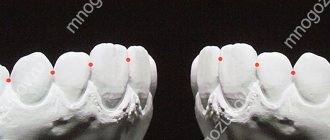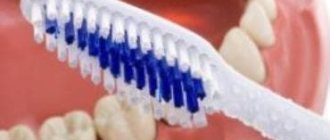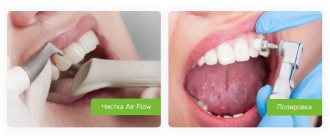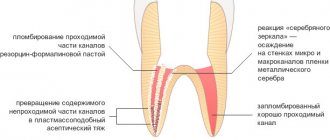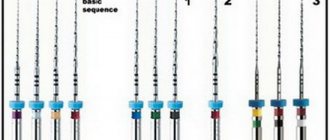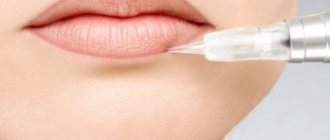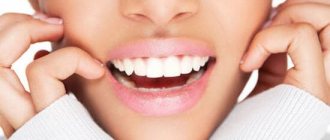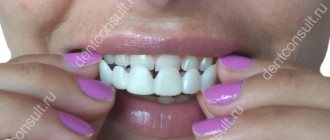4602
In the practice of an orthodontist, the use of a dental mouthguard allows one to eliminate bite problems in children and adults.
They are also used for whitening and for night teeth grinding (bruxism).
The products are removable linings made of silicone or plastic that follow the shape of the dentition.
The accumulation of plaque on the surface of any model requires special and careful care.
The need for daily procedures
Regular and night guards (aligners) require daily care. This is explained by the accumulation of calcium plaque, which increases the growth of pathogenic microflora, causing an unpleasant odor from the mouth.
In addition, a bacterial infection can cause the development of inflammatory processes in the gum tissue (gingivitis, stomatitis). The procedure for hygienic cleaning of the surface of the aligners should be performed in the morning and evening.
When eating, the mouthguard is removed from the mouth. To store it, a special container is used, which must be periodically treated with detergents so that it does not become a “breeding ground” for bacterial pathogens.
It is important to know! The procedure for cleaning the orthodontic structure should be carried out with caution, excluding exposure to high temperatures. You should not use a brush with hard bristles, as it may damage the integrity of the structure of the product material.
Reviews
Like any other thing, the service life of a mouthguard depends very much on the quality of care. If you happen to wear a sports or orthodontic mouthguard, tell us how you looked after it, how many years did it last?
The comment form is located at the bottom of this page.
If you find an error, please select a piece of text and press Ctrl+Enter.
Tags mouth guards Care
Did you like the article? stay tuned
No comments yet
Stages and methods of cleansing
The dental tray should be cleaned at least once a day, and dental hygiene is best done after each meal. A separate toothbrush should be used.
The daily care procedure is carried out using various means.
Soap solution
To do this, you can use detergent or hand soap with an antibacterial effect. Cleaning the surface of the aligners occurs in stages:
- the brush is moistened with warm water;
- a few drops of detergent are applied to its surface;
- cleansing is performed with smooth movements with a brush;
- At the end of the procedure, the aligner is washed under running water to remove any remaining soap solution.
The material used in the production of the Clearcorrect mouth guard and the timing of bite correction.
Come here to learn more about splint therapy in dentistry.
At this address https://orto-info.ru/sistemyi-vyiravnivaniya-zubov/kappyi-elayneryi/flexiligner-effektivnoe-prisposoblenie.html we will look at the features of the Flexiligner aligners.
Bleach
When using a bleaching agent, you must make sure that you are not allergic to its components. The procedure is carried out wearing protective gloves to avoid damage to the skin.
The procedure is performed following the sequence of actions:
- bleach is mixed with water in a ratio of 1:10;
- the orthodontic structure is placed in a container with solution (for 5-10 minutes);
- The tray is washed with running water until the chemical solution is completely eliminated.
Cleansers for dentures
This cleaning method follows the same sequence as using bleach. The difference is that special tablets purchased at the pharmacy are used to prepare the solution.
Need to know! When using bleach or product cleaner, do not soak for more than 10 minutes. Otherwise, the integrity of the aligner may be compromised.
Sterilization
Due to the fact that dental mouth guards are made of plastic materials, boiling sterilization may damage the configuration of the product. In this case, the structure loses its healing qualities, and the correction of the dentition does not occur in full.
After the first fitting in a dental clinic, sterilization is carried out by autoclaving at low temperatures.
Subsequently (after a week), it is recommended to sterilize the mouthguard using special antiseptics. The Avansept-Active solution is suitable for this.
It is used in the following sequence:
- One part of the antiseptic is poured into a glass or enamel container. Add 5 parts of water to it.
- The aligner is immersed in the resulting composition so that the solution layer above its surface is at least 1 centimeter. The structure stays in it for 10 minutes.
- After removal, the product is washed under running water (5 minutes).
This sterilization method is also used to kill the growth of pathogenic microflora in the mouthguard storage container.
Purpose and essence of using Aqualizer for teeth in dentistry.
In this publication you will find objective reviews of anti-snoring mouth guards.
Here https://orto-info.ru/sistemyi-vyiravnivaniya-zubov/kappyi-elayneryi/byinina.html details about the stages of making Bynin’s mouth guard.
Cleaning steps
The orthodontic mouthguard should be cleaned with a separate brush in the morning and evening, and oral care should preferably be carried out after each meal.
Various means are suitable for cleaning the product; below we will consider them in detail.
Liquid soap or detergent
To deeply clean the mouth guard, you can use a soap solution. It is prepared using antibacterial hand soap or dishwashing gel. The hygiene procedure consists of several stages:
- lower the product into the soap mixture;
- moisten the brush and clean the outer and inner surfaces of the mouthguard with smooth circular movements;
- At the end of the procedure, rinse the dental veneer under running warm water and allow to dry naturally.
Tablets for cleaning dentures
Tablets for the care of prosthetic structures will help eliminate bacteria and dirt from the surface of the correction device. Procedure algorithm:
- fill the container with cold water;
- dissolve 1 tablet in it;
- place the mouth guard in the resulting solution and leave for 10-15 minutes;
- rinse the pad well and store in a case;
- Before use, rinse again with water.
Important! It is forbidden to leave the mouth guard in the solution overnight. Aggressive cleaning agents can damage the product.
Bleach
Allergy tests should be performed before using bleach. To do this, moisten a cotton swab in the prepared composition and treat the back of the hand. If there is no redness or other inflammatory reactions, the solution can be used.
To avoid chemical burns to soft tissues, cleansing is performed with gloves.
Stages of manipulation:
- dilute 1 portion of bleach with 10 portions of water;
- pour the prepared solution into a container;
- place the overlay in the composition for 15 minutes;
- Remove the product from the solution and rinse in clean water.
Strengths and weaknesses of Clear Correct aligners, indications for use.
In this publication we will talk about the effectiveness of splint therapy for TMJ diseases.
Here https://www.vash-dentist.ru/ortodontiya/kapyi/elayneryi-flexiligner.html all the most important things about Flexiligner aligners.
Terms of use
In orthodontics, the period of wearing a mouthguard depends on the indications for use. So, after the treatment process using braces, dental veneers are used for one and a half to two years to consolidate the effect.
In some cases they are used for life. At different stages of anchorage therapy after braces, the duration of wearing aligners is:
- for the first 2-3 weeks, orthopedic structures are removed only when eating and during hygienic care;
- after 2 months it is allowed to wear it for 2 hours (during the day) and use the structure at night;
- after 4-6 months, it is enough to wear the product 2-3 times a week;
- After a year and a half, the structure is put on once a week.
If the abnormal bite is minor, then mouthguards can be used as an independent type of treatment. In this case, they must be replaced every 4 weeks. In this case, the duration of treatment can range from 8 months to a year.
To correct minor anomalies, clear aligners are used. They are invisible in the oral cavity, and the ability to remove the structure makes it convenient for everyday cleansing of food debris and plaque.
An important point when wearing corrective dental onlays is periodic visits to the orthodontist for their replacement and preventive examination.
In the video, the specialist will supplement the information presented above.
How long are mouth guards worn and how long can they last?
The duration of wearing depends on the purpose for which the mouth guard is made. To consolidate the results of treatment with braces, the onlay is usually worn for one to two years. Orthodontists sometimes recommend lifelong use of a removable retainer. Of course, one mouthguard will not last your entire life. During scheduled visits to the orthodontist, the doctor monitors the condition of the removable retainer and, if necessary, changes it to a new one.
Treatment with aligners lasts, on average, about a year. At the same time, one aligner is not worn all the time; the aligners are constantly (every two to four weeks) replaced with new ones.
For example, a sports mouthguard is used only during sports activities. Its service life depends on the duration and intensity of training. A high-quality design can last one year or even several years. If the load is too intense, the mouthguard should be changed several times a year.
Mouth guards for correcting bite: what does it feel like?
Aligners are more comfortable than braces - many patients have already convinced themselves of this. However, aligners, like any other orthodontic structure, are a foreign body in the oral cavity that can cause minor discomfort. Patients identify the following problems:
- feeling of a foreign body in the mouth,
- a feeling that the jaws are not closing if the aligners are fixed on the dentition of both jaws,
- a slight violation of diction, because the tongue has to get used to the new position - after all, mouth guards, although slightly, increase the size of the teeth,
- pain in the tongue: he has to adapt to a new position, so he may get tired, because he will be under constant tension,
- minor toothaches, especially in the first days after installing each new aligner, as it puts a lot of pressure on the teeth at the beginning of treatment,
- increased salivation,
- At the end of their wearing period, mouth guards may not have a very good fixation - this can be solved by installing attachments or clasps made of composite materials, which are fixed on the outermost teeth located outside the smile zone. That is, they will be invisible.
Types of whitening trays
There are currently three main types of dental whitening trays on the market. Let's take a closer look at them.
Mouth guards can be different
Standard models
This is the most budget option, which, however, is associated with certain risks. Firstly, this method is not suitable for everyone - the risk of developing an allergic reaction is too high. Secondly, there is a high probability of contact of the lightening gel with the mucous membrane, which can lead to injury. Sets with mouth guards may come with different gels, so you need to choose the option that suits you and strictly follow the instructions, especially regarding dosages and the duration of one session.
Thermoplastic for immersion in hot water
Such products are designed to be lowered into hot water - only after that they are put on a row. The onlay is tightly suctioned to the teeth, due to which it is practically not felt in the mouth and minimizes the degree of discomfort during whitening. This method is considered safer and more effective, however it is somewhat more expensive.
Individual – perfect fit to the enamel
Such products are created in a dental laboratory. The advantages here are on the surface - the aligners contact the enamel as closely as possible, adapt to all the characteristics of the dental system of a particular patient, provide a high level of comfort and guarantee the achievement of the best effect. Even the gel is prepared taking into account the individual characteristics of the patient.
Individual models fit snugly to the teeth
What else do you need to know
- Do not chew the mouthguard, this will significantly shorten its service life and make it fit worse.
- Do not drink anything other than water during use. Especially avoid drinks containing sugar, as well as protein shakes. If you drink anything other than water, remove the mouth guard.
- Take your mouthguard with you when you go to the dentist for a checkup. Show him your model and ask his opinion on how it fits.
Based on materials from Jiu Jitsu Magazine
Large range of protection for martial arts:
- Boxing mouthguards;
- Boxing wraps;
- Groin protection.
How much does it cost to install aligners?
Many people think that since we use the latest technology to create FlexiLigner aligners, the cost of aligners will be exorbitant. This is wrong. For example, mild clinical cases can be cured for 60–80 thousand rubles. The more complex the situation, the longer the treatment will take and the more flexes you will need. Naturally, in such a situation, the cost of aligners will increase and will be approximately equal to the cost of treatment with an aesthetic braces system. But unlike braces, you will not feel any discomfort throughout the treatment.
If you are interested in the question in which cities it is possible to install aligners from Flexiliner, we hasten to please you that this is not only Moscow, and not even only Russia. We also cooperate with clinics throughout the CIS.
I would like to note that the cost of dental aligners in Moscow, Voronezh, St. Petersburg, Tyumen, Simferopol and other cities is fixed at the time the price is announced. We have a transparent policy and no hidden overpayments.
The price is influenced by various factors:
- duration of treatment;
- category of treatment complexity (how severely the teeth are crooked);
- How many sets of aligners will be needed?
You can find out the exact cost of a course of treatment after a preliminary consultation with a specialist.
Don't forget that you will need to clean up your mouth before wearing aligners. Treatment of caries, inflammatory processes, teeth cleaning and other services also require additional costs.
The cost of making mouth guards includes making impressions and other diagnostic data, drawing up a treatment plan by the doctor, manufacturing the required number of sets of products, prescribing additional therapy if necessary, regular monitoring and much more.


